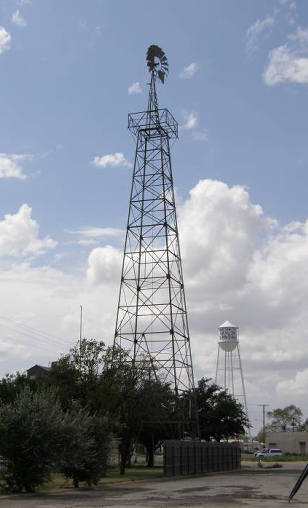| |
In
1887, the Panhandle and much
of the rest of Texas suffered from one of the worst
droughts in the state’s known history.
On the giant
XIT, land the state had conveyed to a group of investors to fund construction
of a new capitol
in Austin, ranch management faced a
problem – too many cattle with too little if any ground water. To make matters
worse, the ranch had more livestock on the way.
The water shortage had
grown particularly acute on the southern end of the ranch in the Yellow House
Division, the acreage intended to serve as the XIT’s
enormous breeding pasture. One of the seven (eventually eight) separately run
ranches that made up the 3 million-acre spread on the western edge of the Panhandle,
Yellow House got its name because of its most striking geographic feature, known
originally as El Canyon de Casa Amarillas. A South Plains landmark since first
noted by Spanish explorers, the canyon stretches to the northwest of Lubbock
for 35 miles.
To provide enough water for the livestock expected on the
Yellow House, ranch manager B.H. “Barbecue” Campbell contracted with two drillers
to bring in water wells in the canyon. After a slow start, the men finally made
two shallow wells with modest flows, but Campbell wanted artesian water. A surveying
crew continued looking for likely drilling sites and a series of deep and shallow
wells came in as the canyon began to sprout wooden windmills like so many sunflowers.
Averaging 34 feet high, the towers supported wheels ranging from 12 to 18 feet
across.
But in the deeper end of the canyon, a 34-foot windmill did not
get enough wind. Pondering the problem, someone came up with the sensible idea
of building a windmill tall enough to poke above the sides of the canyon so it
could catch the generally more robust wind blowing across the open plains.
The resulting wooden windmill tower rose 132 feet – the equivalent of a 13-story
building -- to support a wheel with 12-foot blades. When operable, it worked just
fine, but the mill stood so tall the ranch had trouble finding a windmill man
brave – or dumb – enough to climb to the top to do maintenance. Recruitment became
even more difficult after one man fell to his death from the giant mill.
In the early 1900s, the XIT’s
owners – struggling for a return on investment they had yet to realize -- decided
to discontinue raising cattle. Their new business model would be breaking up their
huge acreage and selling smaller parcels as ranches or farms.
Austin-based
cattleman George
W. Littlefield bought the 312,175-acre Yellow House Division in the summer
of 1901 for two dollars an acre and renamed it the Yellow House Ranch. In addition,
he purchased 5,000 cows and 200 registered Hereford bulls from the XIT,
placing them on his new holding.
Having done well in the cattle business
and as a banker, in 1912 Littlefield
signed a contract with the Santa Fe Railroad granting right of way across his
land. Realizing the railroad would bring more people to that part of the Plains
he organized the Littlefield Land Co. the same year and set aside land for the
Lamb County town that would bear his name.
Managed by Littlefield’s
nephew, the ranch continued in operation until Littlefield’s
death in 1920. Not long after, the Littlefield
estate sold the rest of the land. Whether the giant windmill in Yellow House canyon
still functioned at that point is not known, but a windstorm on Thanksgiving Day
in 1926 turned it into so much scrap lumber.
Forty-one years passed before
someone suggested to the Littlefield
Chamber of Commerce in 1967 that it ought to build a replica of the old XIT
giant as a tourist attraction. Liking the idea, the chamber came up with the money
and got the Santa Fe Railroad to donate land near its depot at SH 84 and XIT Avenue
(known as Delano Street at the time) to accommodate the tower. Longtime windmill
man Buck Ross headed the crew that put the new tower together and raised it on
May 27, 1969. |
 |
Unlike its historic
predecessor, the new steel tower rose only 114 feet. Even with a 12-foot wheel
on top, it lacked six feet matching the original. Nevertheless, the Littlefield
chamber proclaimed it the world’s tallest windmill and began touting it as a must-see
for visitors. A year later, the Texas Historical Commission put up a historical
marker.
Unfortunately for Littlefield
boosters, it no longer has the world’s tallest windmill. Alas, the Lamb County
seat can’t even brag about Texas’s tallest. That
distinction now belongs to a collection of wind turbines outside Snyder
in Scurry County that rise 345 feet.
The towers weren’t built with any
intent to best Littlefield’s
big windmill. Just as was the case with the original XIT
giant, it’s all about reaching the prevailing wind.
© Mike
Cox
- September 27, 2012 column
More "Texas
Tales"
See Littlefield,
Texas | George
W. Littlefield |
Related Topics: Columns
| People |
Texas | Texas Town List |
|
Books by Mike Cox - Order Now | |
| Book Hotel Here
- Expedia
Affiliate Network | |